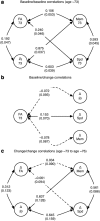Coupled changes in brain white matter microstructure and fluid intelligence in later life
- PMID: 26041932
- PMCID: PMC4452562
- DOI: 10.1523/JNEUROSCI.0862-15.2015
Coupled changes in brain white matter microstructure and fluid intelligence in later life
Abstract
Understanding aging-related cognitive decline is of growing importance in aging societies, but relatively little is known about its neural substrates. Measures of white matter microstructure are known to correlate cross-sectionally with cognitive ability measures, but only a few small studies have tested for longitudinal relations among these variables. We tested whether there were coupled changes in brain white matter microstructure indexed by fractional anisotropy (FA) and three broad cognitive domains (fluid intelligence, processing speed, and memory) in a large cohort of human participants with longitudinal diffusion tensor MRI and detailed cognitive data taken at ages 73 years (n = 731) and 76 years (n = 488). Longitudinal changes in white matter microstructure were coupled with changes in fluid intelligence, but not with processing speed or memory. Individuals with higher baseline white matter FA showed less subsequent decline in processing speed. Our results provide evidence for a longitudinal link between changes in white matter microstructure and aging-related cognitive decline during the eighth decade of life. They are consistent with theoretical perspectives positing that a corticocortical "disconnection" partly explains cognitive aging.
Keywords: cognitive aging; diffusion tensor imaging; fluid intelligence; fractional anisotropy; processing speed; white matter microstructure.
Copyright © 2015 Ritchie et al.
Figures



References
-
- Booth T, Bastin ME, Penke L, Maniega SM, Murray C, Royle NA, Gow AJ, Corley J, Henderson RD, Starr JM, Wardlaw JM, Deary IJ. Brain white matter tract integrity and cognitive abilities in community-dwelling older people: the Lothian Birth Cohort, 1936. Neuropsychology. 2013;27:595–607. doi: 10.1037/a0033354. - DOI - PMC - PubMed
Publication types
MeSH terms
Grants and funding
LinkOut - more resources
Full Text Sources
